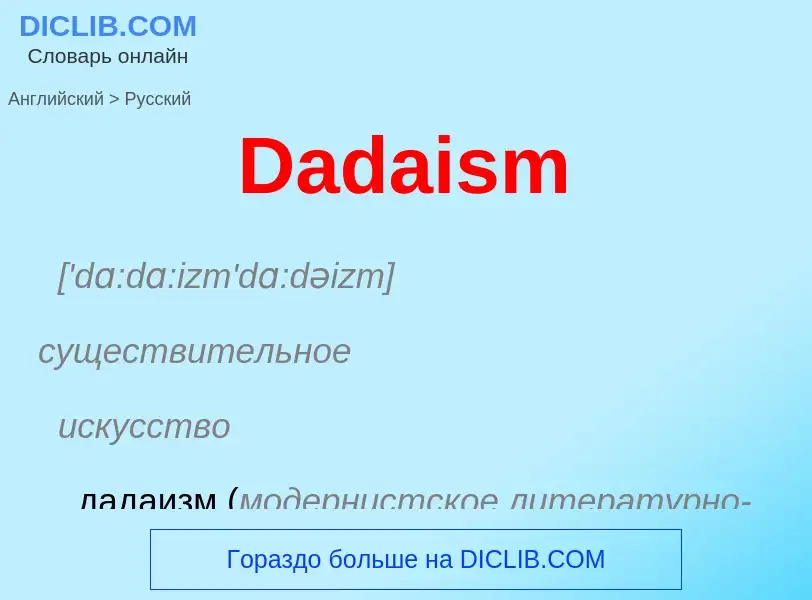Vertaling en analyse van woorden door kunstmatige intelligentie ChatGPT
Op deze pagina kunt u een gedetailleerde analyse krijgen van een woord of zin, geproduceerd met behulp van de beste kunstmatige intelligentietechnologie tot nu toe:
- hoe het woord wordt gebruikt
- gebruiksfrequentie
- het wordt vaker gebruikt in mondelinge of schriftelijke toespraken
- opties voor woordvertaling
- Gebruiksvoorbeelden (meerdere zinnen met vertaling)
- etymologie
Dadaism - vertaling naar russisch
['dɑ:dɑ:izm'dɑ:dəizm]
существительное
искусство
дадаизм (модернистское литературно-художественное течение первой четверти XX века)
['dɑ:dɑ:izm'dɑ:dəizm]
существительное
искусство
дадаизм (модернистское литературно-художественное течение первой четверти XX века)
Definitie
Wikipedia

Dada () or Dadaism was an art movement of the European avant-garde in the early 20th century, with early centres in Zürich, Switzerland, at the Cabaret Voltaire (in 1916). New York Dada began c. 1915, and after 1920 Dada flourished in Paris. Dadaist activities lasted until the mid 1920s.
Developed in reaction to World War I, the Dada movement consisted of artists who rejected the logic, reason, and aestheticism of modern capitalist society, instead expressing nonsense, irrationality, and anti-bourgeois protest in their works. The art of the movement spanned visual, literary, and sound media, including collage, sound poetry, cut-up writing, and sculpture. Dadaist artists expressed their discontent toward violence, war, and nationalism and maintained political affinities with radical politics on the left-wing and far-left politics.
There is no consensus on the origin of the movement's name; a common story is that the German artist Richard Huelsenbeck slid a paper knife (letter-opener) at random into a dictionary, where it landed on "dada", a colloquial French term for a hobby horse. Jean Arp wrote that Tristan Tzara invented the word at 6 p.m. on 6 February 1916, in the Café de la Terrasse in Zürich. Others note that it suggests the first words of a child, evoking a childishness and absurdity that appealed to the group. Still others speculate that the word might have been chosen to evoke a similar meaning (or no meaning at all) in any language, reflecting the movement's internationalism.
The roots of Dada lie in pre-war avant-garde. The term anti-art, a precursor to Dada, was coined by Marcel Duchamp around 1913 to characterize works that challenge accepted definitions of art. Cubism and the development of collage and abstract art would inform the movement's detachment from the constraints of reality and convention. The work of French poets, Italian Futurists and the German Expressionists would influence Dada's rejection of the tight correlation between words and meaning. Works such as Ubu Roi (1896) by Alfred Jarry and the ballet Parade (1916–17) by Erik Satie would also be characterized as proto-Dadaist works. The Dada movement's principles were first collected in Hugo Ball's Dada Manifesto in 1916.
The Dadaist movement included public gatherings, demonstrations, and publication of art/literary journals; passionate coverage of art, politics, and culture were topics often discussed in a variety of media. Key figures in the movement included Jean Arp, Johannes Baader, Hugo Ball, Marcel Duchamp, Max Ernst, Elsa von Freytag-Loringhoven, George Grosz, Raoul Hausmann, John Heartfield, Emmy Hennings, Hannah Höch, Richard Huelsenbeck, Francis Picabia, Man Ray, Hans Richter, Kurt Schwitters, Sophie Taeuber-Arp, Tristan Tzara, and Beatrice Wood, among others. The movement influenced later styles like the avant-garde and downtown music movements, and groups including Surrealism, nouveau réalisme, pop art and Fluxus.




![Cover of the first edition of the publication ''Dada'', [[Tristan Tzara]]; Zürich, 1917 Cover of the first edition of the publication ''Dada'', [[Tristan Tzara]]; Zürich, 1917](https://commons.wikimedia.org/wiki/Special:FilePath/Dada1.jpg?width=200)
![Celine Arnauld]], [[Francis Picabia]], [[André Breton]]. Celine Arnauld]], [[Francis Picabia]], [[André Breton]].](https://commons.wikimedia.org/wiki/Special:FilePath/Dada artists, group photograph, 1920, Paris.jpg?width=200)

![''[[Dadaglobe]]'' solicitation form letter signed by Francis Picabia, Tristan Tzara, Georges Ribemont-Dessaignes, and Walter Serner, c. week of November 8, 1920. This example was sent from Paris to Alfred Vagts in Munich. ''[[Dadaglobe]]'' solicitation form letter signed by Francis Picabia, Tristan Tzara, Georges Ribemont-Dessaignes, and Walter Serner, c. week of November 8, 1920. This example was sent from Paris to Alfred Vagts in Munich.](https://commons.wikimedia.org/wiki/Special:FilePath/Dadaglobe Form Letter to Vagts (Nov 1920).jpg?width=200)
![The [[Janco Dada Museum]], named after [[Marcel Janco]], in [[Ein Hod]], Israel The [[Janco Dada Museum]], named after [[Marcel Janco]], in [[Ein Hod]], Israel](https://commons.wikimedia.org/wiki/Special:FilePath/En hod dada museum.jpg?width=200)
![[[Francis Picabia]]: left, ''Le saint des saints c'est de moi qu'il s'agit dans ce portrait'', 1 July 1915; center, ''Portrait d'une jeune fille americaine dans l'état de nudité'', 5 July 1915; right, ''J'ai vu et c'est de toi qu'il s'agit, De Zayas! De Zayas! Je suis venu sur les rivages du Pont-Euxin'', New York, 1915 [[Francis Picabia]]: left, ''Le saint des saints c'est de moi qu'il s'agit dans ce portrait'', 1 July 1915; center, ''Portrait d'une jeune fille americaine dans l'état de nudité'', 5 July 1915; right, ''J'ai vu et c'est de toi qu'il s'agit, De Zayas! De Zayas! Je suis venu sur les rivages du Pont-Euxin'', New York, 1915](https://commons.wikimedia.org/wiki/Special:FilePath/Francis Picabia, 1915, New York..jpg?width=200)
![[[Francis Picabia]], ''Dame!'' Illustration for the cover of the periodical ''Dadaphone'', n. 7, Paris, March 1920 [[Francis Picabia]], ''Dame!'' Illustration for the cover of the periodical ''Dadaphone'', n. 7, Paris, March 1920](https://commons.wikimedia.org/wiki/Special:FilePath/Francis Picabia, Dame! Illustration for the cover of the periodical Dadaphone n. 7, Paris, March 1920.jpg?width=200)
![Nationalgalerie, Staatliche Museen zu Berlin]] Nationalgalerie, Staatliche Museen zu Berlin]]](https://commons.wikimedia.org/wiki/Special:FilePath/Hoch-Cut With the Kitchen Knife.jpg?width=200)

![[[Rrose Sélavy]], the alter ego of Dadaist [[Marcel Duchamp]] [[Rrose Sélavy]], the alter ego of Dadaist [[Marcel Duchamp]]](https://commons.wikimedia.org/wiki/Special:FilePath/Label for the Belle Haleine cropped.png?width=200)

![[[Man Ray]], c. 1921–22, ''Rencontre dans la porte tournante'', published on the cover of ''[[Der Sturm]]'', Volume 13, Number 3, 5 March 1922 [[Man Ray]], c. 1921–22, ''Rencontre dans la porte tournante'', published on the cover of ''[[Der Sturm]]'', Volume 13, Number 3, 5 March 1922](https://commons.wikimedia.org/wiki/Special:FilePath/Man Ray, Rencontre dans la porte tournante.jpg?width=200)
![Fountain]],'' 1917; photograph by [[Alfred Stieglitz]] Fountain]],'' 1917; photograph by [[Alfred Stieglitz]]](https://commons.wikimedia.org/wiki/Special:FilePath/Marcel Duchamp, 1917, Fountain, photograph by Alfred Stieglitz.jpg?width=200)
